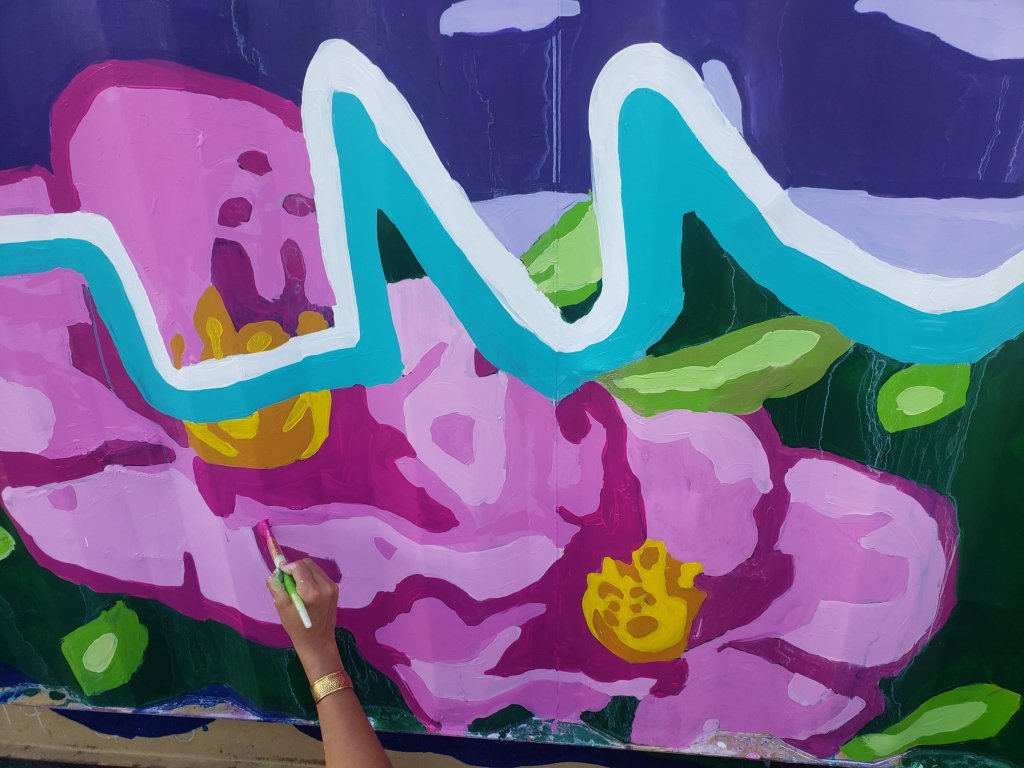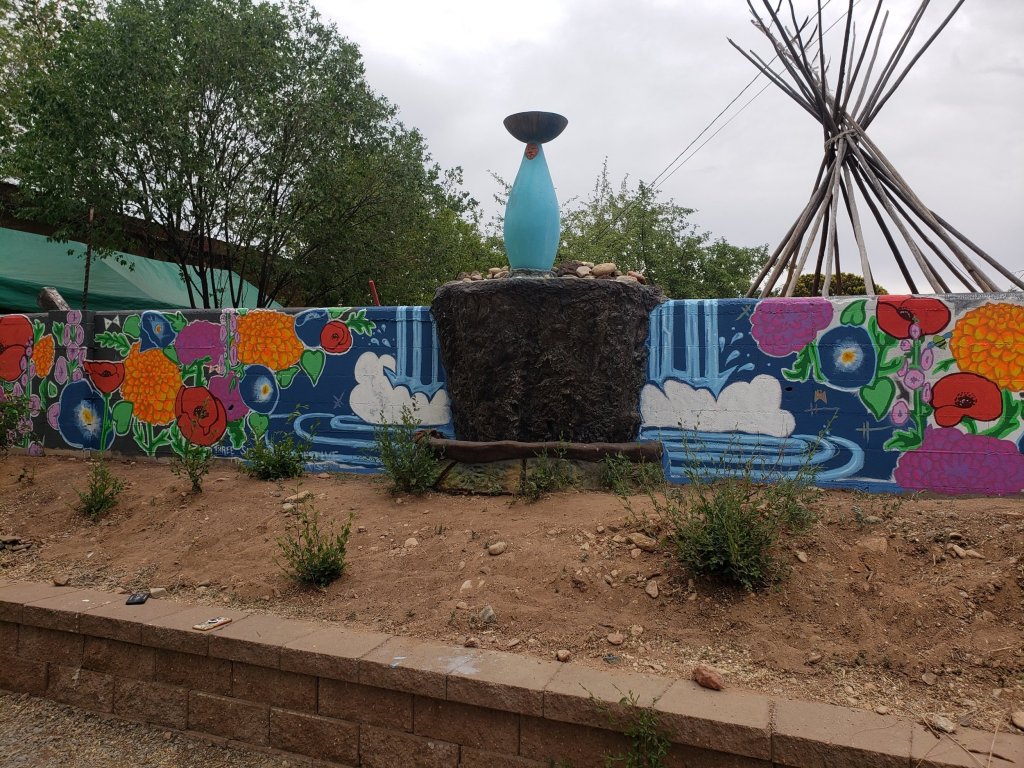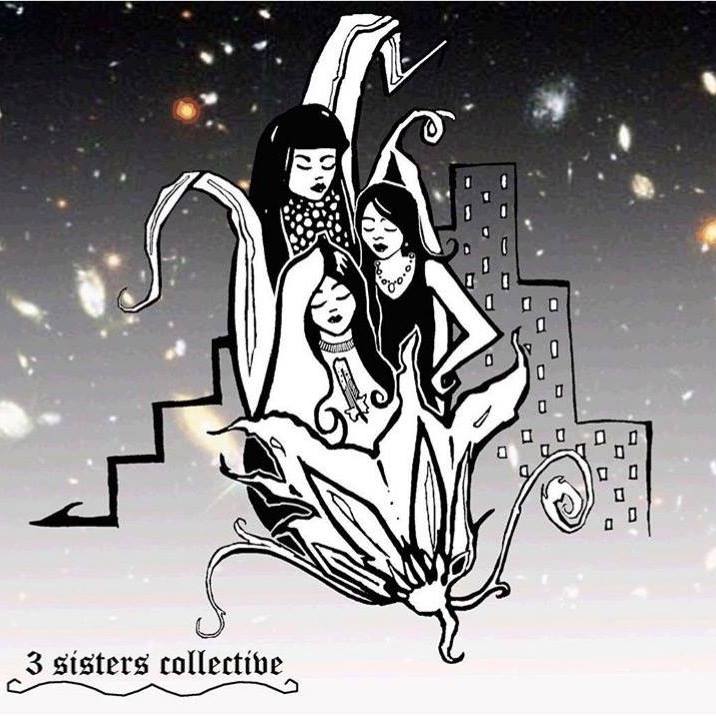
“Honor Beautiful Bvlbancha”
Power Shift Network x Three Sisters Collective | John Thompson Legacy Center, Bvlbancha/New Orleans | 2023





“Representation matters! For us, murals are a continuation of the visual narratives found on petroglyphs and sacred spaces that preserve our unwritten stories. Murals often offer untold stories of the communities they are found in.”
— Three Sisters Collective

“Connected: A Collective Dreaming”
Indian Pueblo Culture Center x Three Sisters Collective | Indian Pueblo Cultural Center, Albuquerque | 2023





“Corn Maiden Storyteller: Shards of Our Stories”
Pola Lopez© | Three Sisters Collective | O’ga P’ogeh /Santa Fe | 2022

This mural is based on the concept that the keeper and progenitor of stories in a culture is pivotal in remembering our history, our experiences and making us aware of our present and the coming future. The Storyteller aligns us with our roots and allows us to grow in knowledge of who we are and who we can be.
We honor Corn Maiden as the storyteller at the center of this mural. Corn Mother, or Corn Maiden, is the giver of life. She is synonymous with Mother Earth and represents growth, life, creativity and the feminine aspects of the world. In traditional storyteller fashion, she carries the stories and she is the mother to the children who sit on her lap who she cradles with her knowledge.
Corn Maiden aka (also known as) Turkey Girl, in folk tale narratives, is our main character, representative of the persecuted heroine type. Turkey girl tales, tell of her resistance to Spanish reconquest efforts 1681-1694. The tales recount how Corn Maiden and her turkeys escape up local canyons and mountain sanctuaries, and how Turkey Girl resisted Franciscan conversion efforts.
Turkey Girl who represents Corn Maiden feeds her turkey, charges her corn kernels and shares with them a close kinship and relationship. Their feathers were revered as used as ritual and ceremonial objects, as well as with Katsinas, and created into blankets for burial. There was a symbolic importance of turkey feathers to rainmaking ideology, and were associated with rain clouds, maize and the dead, who can become cloud spirits and bring rain.
Puebloan women’s long lasting social bond with domesticated turkeys was disrupted by the Spanish Maize and textile tribute, la encomienda systems and their demands on native labor, slavery otherwise known as the Spanish repartimiento, which was a factor leading to the Pueblo Revolt.
The mural will be situated in the historical Agua Fria area of O’ga P’ogeh, Santa Fe, which was originally named Ca-Tee-Ka by Tewa and Tano peoples along the Rio Grande, and this means “cold water.” There are two major Late Puebloan archaeological sites in the area, one identified as Pindi Pueblo and estimates a 3,000-3,500 BCE date for residents who dwelled in pit houses and who practiced turkey husbandry, by raising and domesticating turkeys. Pindi is a Tewa word that translates to turkey. Women were the primary turkey caregivers.
The theme follows a few of the stories that Corn Maiden aka Turkey Girl carries and portrays them on pieces of black and white pottery shards like those found at the Pindi Pueblo site. There are six pottery shards and the story being conveyed on each pottery shard is simply portrayed by symbols that represent key issues faced in the past and now into the present.
The first shard, beginning at the left, is represented by La Virgen the Guadalupe, a religious figure which was more readily accepted by the indigenous people of Mexico and traveled up north and replaced La Conquistadora, which was carried here by the Spanish. La Virgen de Guadalulpe also took the place of Corn Mother, as the Native people were not allowed to practice their spiritual beliefs because of Spanish colonial ignorance and fear. La Virgen de Guadalupe is now revered by all, and accepted by the culture as she represents the Virgen of the Mestisaje, and was a blended image of indigenous iconography and belief systems with Spanish imagery.
The Second shard represents this Mestizaje, that she represents, and that arose from the mixing of European blood with the native people. The three-headed man depicted here is a Chicano iconic symbol and is representative of the cultures that created the Mestizos. The Indigenous man (native to this land) at the center, the Black man (enslaved) to his right and the European man (conqueror) to his left. Above his head is another image from the Chicano Movimiento, the United Farmworkers eagle; a symbol for the rights of the workers. It was the first symbol of resistance from the people. Eagle represents the power of the Great Spirit, the connection to the Divine. Eagle medicine is the ability to live in the realm of spirit, and yet remain connected and balanced within the realm of Earth. Eagle soars, and is quick to observe expansiveness within the overall pattern of life.
The concept of Mestizaje came with the Spanish Casta, a socioeconomic hierarchical caste system based on race, that not only classified your race but also identified your social standing. The Casta System was the natural evolution of the medieval Spanish idea of limpieza de sangre, or blood purity. Words are placed throughout the mural to give an added understanding of the images. The words surrounding this shard are mestizaje and raza cosmica.
In 1925, Mexican philosopher José Vasconcelos wrote a book called “La Raza Cósmica”, which expressed the ideology of a future “fifth race” in the Americas. This new race of people would be called “La Raza Cósmica”, because Latin Americans are Mestizos – a mix of European, African and Asian ancestry, he believed they actually transcend all other races. These first two shards express the elements from the past that have shaped us. Even though there was resistance to this blending and all genocidal efforts by the conquering peoples, a fusion and melding was inevitable, but it was not complete and there exists today still an identity crisis that is hard to deny for some.
The third shard, is a current day issue as indicated by the MMIW letters that surround the shard that contains a red hand and a red dress. MMIW stands for Murdered and Missing Indigenous Women. The woman again as the victim and casualty of the culture. The symbol of the hand, normally a symbol for humanity or the journey, is made more meaningful when drenched in red for blood and represents women who have been silenced and can no longer use their voice. There is now a movement of resistance to this happening to our indigenous women. Turkey girl is alive in this movement. We wear a red dress and a red hand over our mouth to remember, to show we will use our voice for these lost women.
This brings us to the center of the mural where sits the Corn Maiden Storyteller. She is sitting in a circle of energy that the lightning that zig-zags across the whole face of the mural in the background creates as it meets in the center. The lightning reflects the association with rain clouds and its connection to the turkey feathers. Also, everything held in the circle is sacred, this is sacred geometry, the divine spark.
She has four children climbing on her in traditional fashion, as it is important that the stories get passed onto the new generations. She is flanked on either side by two turkeys, two “Pindi” which represent her association with Turkey girl and emphasize their importance in the history of the first people. They are done in a style found on pottery created during that period. They are surrounded by corn kernels tossed on the ground.

This mural is based on the concept that the keeper and progenitor of stories in a culture is pivotal in remembering our history, our experiences and making us aware of our present and the coming future. The Storyteller aligns us with our roots and allows us to grow in knowledge of who we are and who we can be.
We honor Corn Maiden as the storyteller at the center of this mural. Corn Mother, or Corn Maiden, is the giver of life. She is synonymous with Mother Earth and represents growth, life, creativity and the feminine aspects of the world. In traditional storyteller fashion, she carries the stories and she is the mother to the children who sit on her lap who she cradles with her knowledge.
Corn Maiden aka (also known as) Turkey Girl, in folk tale narratives, is our main character, representative of the persecuted heroine type. Turkey girl tales, tell of her resistance to Spanish reconquest efforts 1681-1694. The tales recount how Corn Maiden and her turkeys escape up local canyons and mountain sanctuaries, and how Turkey Girl resisted Franciscan conversion efforts.
Turkey Girl who represents Corn Maiden feeds her turkey, charges her corn kernels and shares with them a close kinship and relationship. Their feathers were revered as used as ritual and ceremonial objects, as well as with Katsinas, and created into blankets for burial. There was a symbolic importance of turkey feathers to rainmaking ideology, and were associated with rain clouds, maize and the dead, who can become cloud spirits and bring rain.
Puebloan women’s long lasting social bond with domesticated turkeys was disrupted by the Spanish Maize and textile tribute, la encomienda systems and their demands on native labor, slavery otherwise known as the Spanish repartimiento, which was a factor leading to the Pueblo Revolt.
The fourth shard takes us back to the past but now a current issue, that of the boarding schools, as the words state. Depicted on this shard are the cut braids of the innocent students that went through this system of assimilation. Again, an assault on the belief system of native people that their hair is their connection to spirit, to the earth, our antennae and how we perceive energy. It is our power and strength.
The fifth shard, is a portrayal of the Matachine Dance, which is a dance-drama of Spanish, Morro and Indigenous influences and is a tradition in the Hispanic Southwest. It is one of the very few dances shared by both Hispanic and Native Peoples.
Scholars who have studied the dance have suggested that los Matachines is a homoerotic dance, that is, a dance done by men, for men, since female figures were not originally part of the dance. The only female figure in the dance, an ogress called la Perejundia, was always played by a man dressed as a woman. In this way, the figure was assured of having both the strength of the man and the power of the woman.


The newest addition to the dance-drama is the little girl figure called la Malinche. La Malinche, a Nahua woman named Malintzin, became known for contributing to the Spanish conquest of the Aztec Empire, by acting as an interpreter, advisor, intermediary and concubine for the Spanish conquistador Hernán Cortés. Her children were the first of the mestizaje and her role is controversial because she is considered a traitor by many and a savior by others. In the dance-drama, the Matachines escort Malinche into the dance and she is presented as someone pivotal. She is usually portrayed by a very young girl dressed in a white communal outfit.
The sixth and last shard, is about Land back and the protection and stewardship of our mother earth and its’ resources. There is a landscape portrayed in this scene with a river running through it and the words Mini Wiconi above it which means Water is Sacred. Floating in the sky is a Medicine wheel that indicates healing and walking in beauty. The four directions, and walking in balance with the earth, the people, the animals and Creator.
There is another circle with a line drawn through it which indicated “No” to fracking, forest fires, nuclear waste, all environmental issues that we are facing in current time here in New Mexico.
On either side of the mural are placed two Heyoka, or Koshari, Sacred clowns, who are watching this all unfold and are Medicine Men who teach us that we are all mirrors of each other, that we take ourselves too seriously as in our egos, and that we need to practice more respect. Wrapped around the curved lines at either end are members of the Three sisters, our main substance, the squash, the beans and of course corn in the center.
The color scheme is done in the method of the Aztec “Tlilli Tlapalli” red and black ink. The red symbolizes the blood, and the black the dark, shadow side. The Aztec Empire believed that these facilitated a connection between the human world and the divine. Red is a powerful color, also representing fire, and energy. Black can be an anchoring color. I chose these colors as the background colors because I felt that the subject matter was intense and needed the color of sacrifice, of offering. The black grounds it all. The black and white shards represent the duality of our dimensional world and the opposites of good versus evil, of light versus dark that we face everyday and especially in our stories.

“As Oga Pogeh, Santa Fe and other communities experience extreme gentrification, this is usually accompanied by a change in aesthetics. Over the last several years, we have witnessed cultural erasure in the form of beloved murals by Indigenous and Chicanx artists being removed in favor of a streamlined, industrial aesthetic, i.e. Santa Fe Railyard District. And as you get closer to the downtown plaza area, the less public facing art you will see due to the city’s restrictions on what they deem a historical “Pueblo Revival” architecture.”
— Three Sisters Collective

“Pueblo Girls’ Garden”
Pueblo Girls Garden x Three Sisters Collective | Santa Fe River Trail, O’ga P’ogeh /Santa Fe | 2022




“Oga Pogeh Owingeh – A visual Land Acknowledgement”
Sabawear x Three Sisters Collective | Full Circle Farm | 2021
“When we create murals, we encourage community involvement from design concepts to painting. Through observation we have learned that inviting the community to engage in the creation of murals that represent our stories is a confidence boost for participants and helps us to move towards becoming better community members by building community and creating positive messaging through public art.”
— Three Sisters Collective

“O’ga P’ogeh: A Visual Land Acknowledgement”
Joerael Numina, Mobilize Walls x Three Sisters Collective | Full Circle Farm, Santa Fe | 2020






“continuamce: o’ga p’ogeh owingeh”
Three Sisters Collective | Museum of Contemporary Native Art, Santa Fe, | 2021



“Murals further challenge passerbys to engage with untold narratives and offer them a chance to interact with our community and learn about what we value.”
— Three Sisters Collective

“ni una mas”
For Three Sisters Collective w/ SABA & Dr. X | Full Circle Farm, Agua Fria | 2021



We are especially grateful to Autumn Dawn Gomez (Taos/Comanche) for bringing the vision of Three Sisters Collective to life through the brilliant mural designs showcased.
autumn dawn (taos pueblo, comanche) is a multi-disciplinary artist practicing in northern new mexico. If you want to follow more of autumn’s work please check out their portfolio here.
